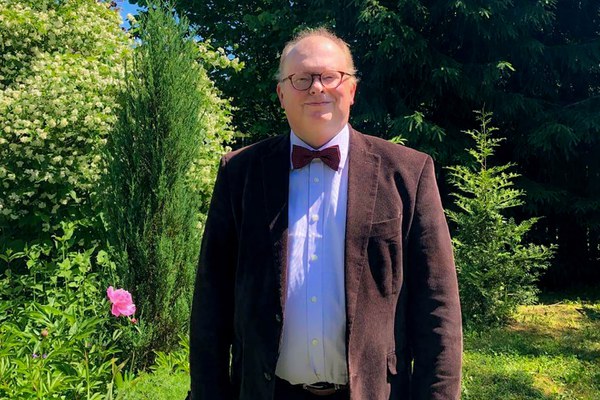Dmitry Korobeynikov, associate professor of history at the University of Albany, was a Byzantine Studies fellow in spring 2021. His research report, “Toward a New Concept of the Christian-Muslim Boundary Zone: Byzance en dehors de Byzance in the Eleventh and Twelfth Centuries,” highlighted the influence of Byzantium abroad through seals.
Q&A with Dmitry Korobeynikov
What is unique about the Byzantine border zone?
I came to understand the importance of the territories beyond Byzantium while I was writing my first monograph, Byzantium and the Turks in the Thirteenth Century; before that, I had studied the Byzantine province of Paphlagonia. At one point I wrote about stable Byzantine borders and my supervisor wrote, “those never existed.” This was something of a surprise to me, and I came to realize the Middle Ages had absolutely different notions of the border than we do today. In the Middle Ages there would have been a much more involved but also flexible system, many of the components of which we still do not understand—we need to create a new notion of Byzantium as an empire that was open to the world and that maintained networks abroad.
What have you learned about the border zone through seals?
We don’t really have descriptions of what people who lived during these times were like—from the textual evidence, we mostly have descriptions of fortresses, roads, etc. Seals offer insights into individuals—they were an opportunity for the sender to express themself, and it is interesting to see what information about these individuals is encoded into these specimens. Dumbarton Oaks has around a hundred of the world’s two hundred known seals with inscriptions in languages other than Greek or Latin, which attest to the network the empire maintained abroad. So when [Curator of Coins and Seals] Jonathan Shea offered me the opportunity to study these specimens several years ago, it was an obvious choice to better understand medieval Byzantine culture abroad.
One unusual seal has an image on the obverse that appears quite Byzantine, but then the reverse has an inscription in Greek and Syriac attributing it to a katalakhtis (from the correct Greek katallaktis), a moneychanger, from Aleppo. It is interesting that this sender states his profession—an unusual one to find on seals, which generally refer to more elite positions—suggesting he was quite attached to and perhaps even proud of his job. Moreover, he was likely living within the borders of the Byzantine Empire, yet he still commemorated the small town he came from.
Another seal or possibly coin (1951.31.5.3275) offers one of very few images of Armenian kings from the medieval period. Armenians were continually warding off attacks from Byzantium and the Abbasid Empire, and as power shifted among the great states of the Middle East, the Armenian principalities were often among the subordinate states of the region. This specimen shows the Armenian King John Senek’erim, who ruled over the territory of Siwnik‘ that today, as part of the Republic of Armenia, separates Turkey from Azerbaijan. This region is quite mountainous, so it was never conquered or ruled by Byzantium. It bordered the empire for only about twenty years; yet at the exact moment Byzantium was crumbling, this king imitated the likeness of a Byzantine vassal, vividly demonstrating the influence of Byzantine culture even at the empire’s lowest point. Other seals I am studying seem to originate from places including Lebanon and Palestine, which should give us an even fuller idea of Byzantine soft power in those regions.
How does this add to our understanding of medieval Byzantium?
One of the biggest challenges of medieval history is our limited primary sources. We have mere particles of the full picture of the past, so we must try to restore a whole picture from the small collection of information and data that remains. We want the people of the past to speak to us, but so much of the information we inherit was produced in the capital city like Constantinople by a relatively elite class using special rhetorical techniques and whatnot to impress their contemporaries, which obscures the details necessary to complete the picture.
These seals and their evident Byzantine influence offer numerous opportunities to understand medieval Byzantine culture in addition to the written tradition, and they suggest that the political and cultural constructs Byzantium had created by the eleventh century died out very slowly, even as the empire disintegrated. Seals also give us information about other Byzantine influences beyond its borders, like Christianity. Christian Arabs, Syriac people, and some Armenians were influenced by Byzantine Christianity, and it is impossible to tell from texts alone how strong those influences abroad were, but imagery and inscriptions invoking saints and the Virgin Mary help us understand where the influence extended to. It has also been fascinating to consider the seals alongside other objects in the collections, like the Byzantine textiles with lions and such, which show Byzantine connections to places like Egypt and the eastern part of Iraq. These objects complement the written culture and demonstrate how the borders between people and empires were not as strong as they might appear to us.
May Wang is postgraduate writing and reporting fellow at Dumbarton Oaks. Photo by Richard Tong, postgraduate digital media fellow.

